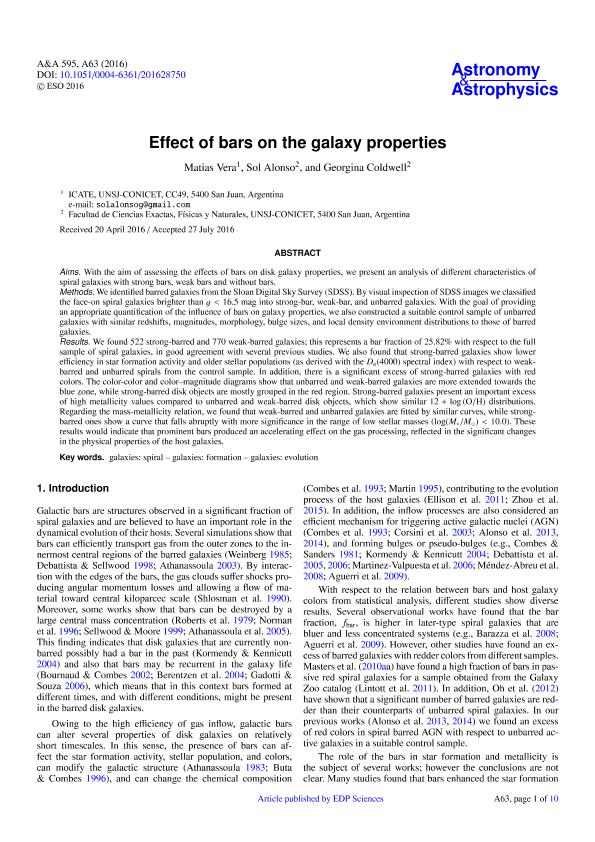Mostrar el registro sencillo del ítem
dc.contributor.author
Vera Rueda, Gustavo Matías

dc.contributor.author
Alonso Giraldes, Maria Sol

dc.contributor.author
Coldwell Lloveras, Georgina Vanesa

dc.date.available
2018-09-28T17:53:19Z
dc.date.issued
2016-11
dc.identifier.citation
Vera Rueda, Gustavo Matías; Alonso Giraldes, Maria Sol; Coldwell Lloveras, Georgina Vanesa; Effect of bars on the galaxy properties; EDP Sciences; Astronomy and Astrophysics; 595; 11-2016; 1-10; A63
dc.identifier.issn
0004-6361
dc.identifier.uri
http://hdl.handle.net/11336/61247
dc.description.abstract
Aims. With the aim of assessing the effects of bars on disk galaxy properties, we present an analysis of different characteristics of spiral galaxies with strong bars, weak bars and without bars. Methods. We identified barred galaxies from the Sloan Digital Sky Survey (SDSS). By visual inspection of SDSS images we classified the face-on spiral galaxies brighter than g< 16.5 mag into strong-bar, weak-bar, and unbarred galaxies. With the goal of providing an appropriate quantification of the influence of bars on galaxy properties, we also constructed a suitable control sample of unbarred galaxies with similar redshifts, magnitudes, morphology, bulge sizes, and local density environment distributions to those of barred galaxies. Results. We found 522 strong-barred and 770 weak-barred galaxies; this represents a bar fraction of 25.82% with respect to the full sample of spiral galaxies, in good agreement with several previous studies. We also found that strong-barred galaxies show lower efficiency in star formation activity and older stellar populations (as derived with the Dn(4000) spectral index) with respect to weak-barred and unbarred spirals from the control sample. In addition, there is a significant excess of strong-barred galaxies with red colors. The color-color and color-magnitude diagrams show that unbarred and weak-barred galaxies are more extended towards the blue zone, while strong-barred disk objects are mostly grouped in the red region. Strong-barred galaxies present an important excess of high metallicity values compared to unbarred and weak-barred disk objects, which show similar distributions. Regarding the mass-metallicity relation, we found that weak-barred and unbarred galaxies are fitted by similar curves, while strong-barred ones show a curve that falls abruptly with more significance in the range of low stellar masses (log (M-/M⊙) < 10.0). These results would indicate that prominent bars produced an accelerating effect on the gas processing, reflected in the significant changes in the physical properties of the host galaxies.
dc.format
application/pdf
dc.language.iso
eng
dc.publisher
EDP Sciences

dc.rights
info:eu-repo/semantics/openAccess
dc.rights.uri
https://creativecommons.org/licenses/by-nc-sa/2.5/ar/
dc.subject
Galaxies: Evolution
dc.subject
Galaxies: Formation
dc.subject
Galaxies: Spiral
dc.subject.classification
Astronomía

dc.subject.classification
Ciencias Físicas

dc.subject.classification
CIENCIAS NATURALES Y EXACTAS

dc.title
Effect of bars on the galaxy properties
dc.type
info:eu-repo/semantics/article
dc.type
info:ar-repo/semantics/artículo
dc.type
info:eu-repo/semantics/publishedVersion
dc.date.updated
2018-09-27T20:16:33Z
dc.journal.volume
595
dc.journal.pagination
1-10; A63
dc.journal.pais
Francia

dc.journal.ciudad
Paris
dc.description.fil
Fil: Vera Rueda, Gustavo Matías. Consejo Nacional de Investigaciones Científicas y Técnicas. Centro Científico Tecnológico Conicet - San Juan. Instituto de Ciencias Astronómicas, de la Tierra y del Espacio. Universidad Nacional de San Juan. Instituto de Ciencias Astronómicas, de la Tierra y del Espacio; Argentina
dc.description.fil
Fil: Alonso Giraldes, Maria Sol. Universidad Nacional de San Juan. Facultad de Ciencias Exactas, Físicas y Naturales; Argentina. Consejo Nacional de Investigaciones Científicas y Técnicas; Argentina
dc.description.fil
Fil: Coldwell Lloveras, Georgina Vanesa. Universidad Nacional de San Juan. Facultad de Ciencias Exactas, Físicas y Naturales; Argentina. Consejo Nacional de Investigaciones Científicas y Técnicas; Argentina
dc.journal.title
Astronomy and Astrophysics

dc.relation.alternativeid
info:eu-repo/semantics/altIdentifier/doi/http://dx.doi.org/10.1051/0004-6361/201628750
dc.relation.alternativeid
info:eu-repo/semantics/altIdentifier/url/https://www.aanda.org/articles/aa/abs/2016/11/aa28750-16/aa28750-16.html
Archivos asociados
